We at Crack4sure are committed to giving students who are preparing for the AAFM CWM_LEVEL_2 Exam the most current and reliable questions . To help people study, we've made some of our Chartered Wealth Manager (CWM) Certification Level II Examination exam materials available for free to everyone. You can take the Free CWM_LEVEL_2 Practice Test as many times as you want. The answers to the practice questions are given, and each answer is explained.
Section A (1 Mark)
How can complaints provide the firm with great value?
Section A (1 Mark)
In a short call, profit is
Section A (1 Mark)
A review of portfolio should be done when
Section A (1 Mark)
The following is capital receipt:
Section A (1 Mark)
With the______________, the buyer gets no protection from encumbrances. This deed type has very specialized uses.
Section A (1 Mark)
A covered call position is equivalent to a
Section A (1 Mark)
An option which gives the holder the right to sell a stock at a specified price at some time in the future is called a
Section B (2 Mark)
Manav wishes to have a retirement corpus of Rs. 2,50,000/- in 30 years’ time. Assuming that he can earn a ROI of 12 % per annum, what amount he should invest yearly into a fund to reach his goal?
Section A (1 Mark)
The tendency, after an event has occured, to think that we knew what was going to happen beforehand. We overestimate the likeliness that we would have been able to predict the outcome of a past series of events. Which of the following is most likely consistent with this bias?
Section B (2 Mark)
Which of the following statements is / are correct?
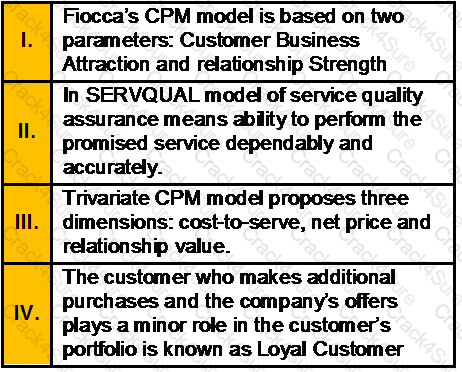
Section B (2 Mark)
Encashment of leave during service tenure is
Section A (1 Mark)
Disclaimers and assumptions are a part of
Section A (1 Mark)
Company J and Company K each recently reported the same earnings per share (EPS). Company J’s stock, however, trades at a higher price. Which of the following statements is most correct?
Section A (1 Mark)
Mr. Raghav is now 40 years old. He has invested some amount in an annuity which will pay him after 10 years Rs. 30,000/- p.a. at the end of every year for 10 years. Rate of interest is 6% p.a. Calculate how much he has invested today?
Section A (1 Mark)
The __________ is NOT a market anomaly.
Section B (2 Mark)
What is the PV of an Annuity Due which provides Rs. 2,000/- per month for first 3 years and then Rs. 3,000/- per month for next 2 years. This annuity starts 4 years from now and ROI is 9 % per annum compounded monthly?
Section B (2 Mark)
The expected market return 16 percent. The risk-free rate of return is 7 percent, and AB Co. has a beta of 1.1. The risk premium is
Section B (2 Mark)
A bank is concerned about excess volatility in its cash flows from some recent business loans it has made. Many of these loans have a fixed rate of interest and the bank's economics department has forecast a sharp increase in interest rates. The bank wants more stable cash flows. Which type of credit derivative contract would you most recommend for this situation?
Section A (1 Mark)
Which of the following is a risk of using credit derivatives?
Section C (4 Mark)
Suppose Sunil visits his favorite coffee shop and encounters his good friend Rohit. Rohit raves about his stockbroker, whose firm employs an analyst who appears to have made many recent successful stock picks. The conversation goes something like this:
SUNIL: Hi, Rohit, how are you?
ROHIT: Hi, Sunil. I’m doing great! I’ve been doing superbly in the market recently.
SUNIL: Really? What’s your secret?
ROHIT: Well, my broker has passed along some great picks made by an analyst at her firm.
SUNIL: Wow, how many of these tips have you gotten?
ROHIT: My broker gave me three great stock picks over the past month or so. Each stock is up now, by over 10 percent.
SUNIL: That’s a great record. My broker seems to give me one bad pick for every good one. It sounds like I need to talk to your broker; she has a much better record!
Which of the following biases have been exhibited by Gaurav?
Section A (1 Mark)
In ________, the values exchanged by the contracting parties may not necessarily be equal
Section B (2 Mark)
Ramesh living in Kolkata is a trustee for Brijesh living in Mumbai, Ramesh remits trust funds to Brijesh by bills drawn by a person of high creditworthiness in favor of the trustee as such and payable at Mumbai. The bills later got dishonored. Is Ramesh bound to make good the loss?
Section C (4 Mark)
Azhar deposits Rs. 12,500 in an account that pays a ROI of 20% p.a compounded annually on 5th. Of March 2010. Calculate the date on which the balance in his account would be Rs.35,338/-
Section B (2 Mark)
The following is not a capital receipt
Section A (1 Mark)
Wages for the purpose of gratuity payment as per the Act means
Section C (4 Mark)
Pacific Asia reported net income of Rs770 million in 1993, after interest expenses of Rs320 million. (The corporate tax rate was 36%.) It reported depreciation of Rs960 million in that year, and capital spending was Rs1.2 billion. The firm also had Rs4 billion in debt outstanding on the books, rated AA (carrying a yield to maturity of 8%), trading at par (up from Rs3.8 billion at the end of 1992). The beta of the stock is 1.05, and there were 200 million shares outstanding (trading at Rs60 per share), with a book value of Rs5 billion. Pacific Asia paid 40% of its earnings as dividends and working capital requirements are negligible. (The Risk Free rate is 7%.)
Estimate the free cash flow to the firm in 1993.
Section C (4 Mark)
Read the senario and answer to the question.
Assuming that Mahesh owns a building which he insures along with its contents for Rs. 12 lakh. However the market value of the building and its content is Rs. 15 lakh. Assuming that the building along with its contents is partially destroyed by fire and the loss assessed of Rs. 1 lakh what is the amount of money insurance company would pay as claim reimbursement to Mahesh?
Section C (4 Mark)
Roger deposits Rs. 10,00,000 in a bank account on 1st March 2005 and another Rs. 5,00,000 on 1st March 2011. He wants to withdraw all of this money with interest on 1st March 2015. If the account pays ROI of 11% p.a. compounded quarterly what amount can he withdraw from this account?
Section A (1 Mark)
Which of the following factors have proven most important in credit scoring models?
Section A (1 Mark)
A(n)_______________ is a credit-rating agency that keeps records of borrowers' loan payment histories.
Section B (2 Mark)
A property has 120 rooms and each room has a monthly rent of Rs.750. The occupancy rate throughout the year is 80% and maintenance expenses per year works out to be Rs.3,00,000. Capitalization rate is 12%. Calculate the value of the property.
Section C (4 Mark)
Blair Company has Rs5 million in total assets. The company’s assets are financed with Rs1 million of debt, and Rs4 million of common equity. The company’s income statement is summarized below:
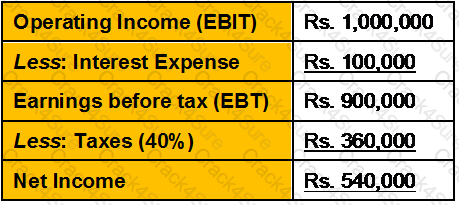
The company wants to increase its assets by Rs1 million, and it plans to finance this increase by issuing Rs1 million in new debt. This action will double the company’s interest expense, but its operating income will remain at 20 percent of its total assets, and its average tax rate will remain at 40 percent. If the company takes this action, which of the following will occur?
Section A (1 Mark)
You have added more money to a losing stock twice, despite no good news about the stock. You are likely demonstrating which type of judgment error?
Section C (4 Mark)
Read the senario and answer to the question.
What would be the taxable amount on gratuity received by Jogen, if he would retired from an organization where employees are not covered under Gratuity Act?
Section B (2 Mark)
As Per Article 11 Double Taxation Avoidance Agreement with UK, a dividend paid by a company which is a resident of the United Kingdom to a resident of India may be taxed in India. Where under paragraph 2 of this Article, a resident of India is entitled to a tax credit in respect of that dividend, tax may also, be charged in the United Kingdom and according to the laws of the United Kingdom on the aggregate of the amount or value of the dividend and the amount of the tax credit, at a rate not exceeding ___________ percent.
Section A (1 Mark)
The best way to maintain your credit rating is to:
Section B (2 Mark)
As a result of a lawsuit, Catherine was awarded $300,000 for compensatory damages and $400,000 for punitive damages. What is the taxable income resulting from this suit?
Section C (4 Mark)
Read the senario and answer to the question.
Assume the following additional facts:
The Shankers have purchased a homeowner’s policy (comprehensive) covering 100% of the replacement cost of their residence. This policy has a Rs. 500 deductible. Also, they have purchased a disability income policy with a 30-day elimination period and an any-occupation definition of disability.
What actions should the Shankers consider in order to improve the quality of the insurance program described above?
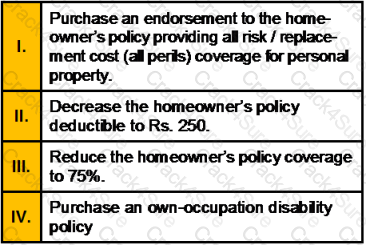
Section A (1 Mark)
Student loan is an example of:
Section B (2 Mark)
If after the partition of an HUF 2 members became partners in 3 firms on behalf of their respective HUFs and they also become partners in a fourth firm. The funds were obtained by means of loans from the other 3 firms. The share incomes of the members from the fourth firm were assessable as their individual income only.
Section A (1 Mark)
The proposed Fair Tax would change the U.S. tax system and instead:
Section B (2 Mark)
Major phases of budgeting process are:
Section A (1 Mark)
The tendency to seek and interpret information that confirms existing beliefs. Our conclusions are unduly biased by what we want to believe. Which of the following is most likely consistent with this bias?
Section B (2 Mark)
The risk-free return is 9 percent and the expected return on a market portfolio is 12 percent. If the required return on a stock is 14 percent, what is its beta?
Section A (1 Mark)
CRM as a discipline that depends on people, process, information and __________
Section B (2 Mark)
In _____________ first the cost incurred by the supplier of property is determined. An appropriate cost plus mark-up is then added to the cost so as to arrive at an appropriate profit in the light of the functions performed and market conditions.
Section A (1 Mark)
Mr. Sharma invested Rs. 2,00,000 in an investment that gives Rs 40,000/- for the first 4 years, and Rs. 60,000/- for next 3 years. If the discount rate is 12 %, calculate the Present Value of these cash flows?
Section A (1 Mark)
Which ONE of the following in not the requirement for managing customer?
Section A (1 Mark)
Hybrid plans are
Section B (2 Mark)
Which of the following statements is/are correct?
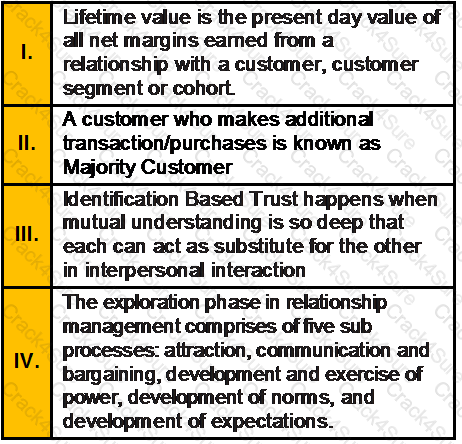
Section A (1 Mark)
Who would get the first preference when the property of a deceased person is to be distributed?
Section B (2 Mark)
Which of the following is a reasonable assumption to make about the understanding of a client on the Wealth planning Process?
Section A (1 Mark)
Mr. Kashyap took a business premise on lease with the provision that he himself had to pay the insurance premium for fire and other perils on the premises and not the owner of the premises. This would be an instance of_______________ on the part of owner of the premises.
Section A (1 Mark)
The last step in fundamental analysis is:
Section A (1 Mark)
Select the correct statement regarding the market portfolio. It:
Section A (1 Mark)
In “Teenage Years” life stage, one learns about ___________
Section B (2 Mark)
What is the future value of Rs. 5000 at the end of 5 years at 8% compounded annually?
Section B (2 Mark)
Calculate the beta on a portfolio from the following data:

Section B (2 Mark)
Which of the following statements regarding a buy and hold strategy are true?
Section A (1 Mark)
______________represents the corollary effect—the irrational denial of responsibility for failure.
Section A (1 Mark)
Mr. Sharma is aged 50 years at present. He has invested some amount in an annuity which will pay him after 10 years Rs. 25,000/- p.a. at the beginning of every year for 10 years. Rate of interest is 6% p.a. Calculate how much amount he has invested now?
Section B (2 Mark)
Which of the following statements is/are correct with respect to Mental Accounting?
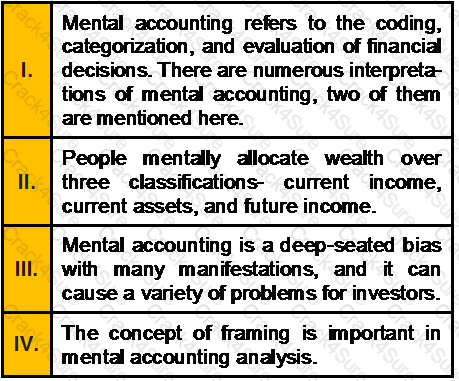
Section B (2 Mark)
Basic Idea of retirement benefit plan is
Section B (2 Mark)
Calculate Gross Annual Value where Gross Municipal Value is Rs.120, Fair Rent is Rs.105. Actual rent receivable is Rs.100& Standard Rent is Rs.125
Section A (1 Mark)
Which of the following options is not true about CODICIL?
Section A (1 Mark)
Surender is a driver who causes injuries to a pedestrian by his rash driving. The injured victim had to spend Rs.1000 in treating his injuries. Surender ‘s act has created liabilities under:
Section A (1 Mark)
We prefer a sure gain from a much larger gain that is very likely but not certain. This makes us close winning positions even if we think that they are likely to get even better.
Section A (1 Mark)
To ensure compliance under this method of lending, the current ratio of the concern should not be less that _________
Section C (4 Mark)
You are considering adding a new product to your firm's existing product line. It should cause a 15 percent increase in your profit margin (i.e., new PM = old PM x 1.15), but it will also require a 50 percent increase in total assets (i.e., new TA = old TA x 1.5). You expect to finance this asset growth entirely by debt. If the following ratios were computed before the change, what will be the new ROE if the new product is added and sales remain constant?
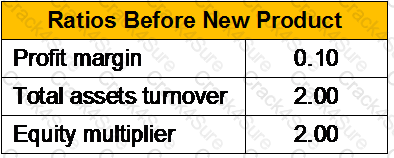
Section C (4 Mark)
Rate of 15% p.a compounded annually will be equal to ---------------- % per month.
Section A (1 Mark)
An investor will take as large a position as possible when an equilibrium price relationship is violated. This is an example of _________.
Section C (4 Mark)
Nifty is at 3200. Mr. XYZ expects large volatility in the Nifty irrespective of which direction the movement is, upwards or downwards. Mr. XYZ buys 2 ATM Nifty Call Options with a strike price of Rs. 3200 at a premium of Rs. 97.90 each, sells 1 ITM Nifty Call Option with a strike price of Rs. 3100 at a premium of Rs. 141.55 and sells 1 OTM Nifty Call Option with a strike price of Rs. 3300 at a premium of Rs. 64.
What would be the Net Payoff of the Strategy?
• If Nifty closes at 2929
• If Nifty closes at 4325
Section A (1 Mark)
If POA in respect of in moveable property of value more than ………………….it must be registered
Section B (2 Mark)
Mr.Neeraj has a portfolio consisting of two stocks A & B has a standard deviation of 5% while stock B has a standard deviation of 15%. Stock A comprises 40% of the portfolio and stock B consists of 60%. If the correlation of returns of A and B is 0.5, the variance of return on the portfolio is_______
Section C (4 Mark)
As a CWM you are required to calculate the tax liability of an individual whose Taxable income is:
• $125000 in US dollars and he is a US citizen (single individual)
• $109000 in SGD and he is a citizen of Singapore
Section A (1 Mark)
An activity is presumed to be a profit-making activity rather than a hobby if the
Section B (2 Mark)
It was unconstitutional for the U.S. government to levy an income tax before the passage of which amendment?
Section A (1 Mark)
The first step of portfolio management is:
Section B (2 Mark)
Hybrid plans are
Section B (2 Mark)
In the year to 31 March 2012, a UK resident company made a UK trading profit of £800,000 and received net overseas income of £26,000 (net of 20% withholding tax). These were the company's only sources of income. The company also paid a qualifying charitable donation of £5,000.
For double tax relief purposes, the charitable donation will be allocated as a deduction from the company's overseas income. True or False?
Section A (1 Mark)
The _______ is typically taken to be the risk-free rate.
Section B (2 Mark)
A bond has a market value of Rs100,000 and a duration of 9.42. What is the price value of a basis point?
Section A (1 Mark)
Under which of the following categories of General Warranty Deed does the buyer is guaranteed that the title will be good against third parties attempting to establish title to the property?
Section A (1 Mark)
___________ is a measure of the ratio between the net income produced by an assets (usually real estate) and its capital cost.
Section A (1 Mark)
In order to have confirmation of a major market trend under the Dow Theory, the
Section B (2 Mark)
Which of the following statements is/are true?
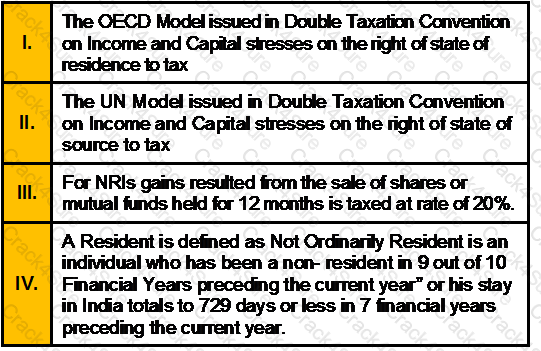
Section A (1 Mark)
Which of the following statements about Real Estate Investment Trusts is/are true?
Section C (4 Mark)
Your company had the following balance sheet and income statement information for 2003:
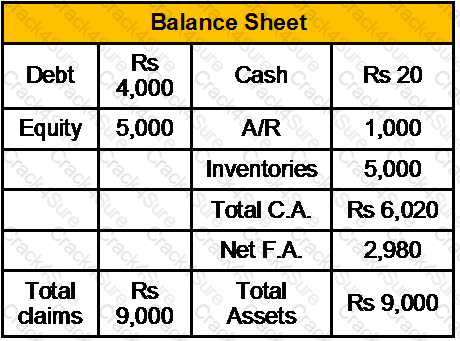
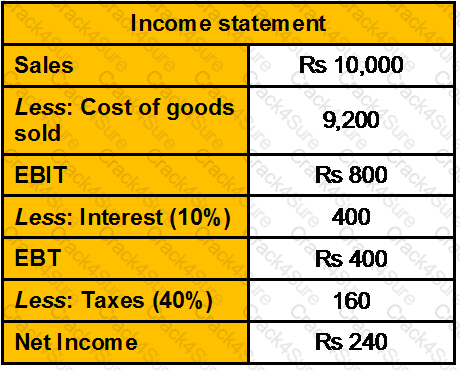
The industry average inventory turnover is 5. You think you can change your inventory control system so as to cause your turnover to equal the industry average, and this change is expected to have no effect on either sales or cost of goods sold. The cash generated from reducing inventories will be used to buy tax-exempt securities which have a 7 percent rate of return. What will your profit margin be after the change in inventories is reflected in the income statement?
Section B (2 Mark)
Consider a one-year maturity call option and a one-year put option on the same stock, both with striking price Rs45. If the risk-free rate is 4%, the stock price is Rs48, and the put sells for Rs1.50, what should be the price of the call?
Section B (2 Mark)
In a “Pure Play” model of wealth management
Section C (4 Mark)
Suppose Nifty is at 4500 in May. An investor, Mr. A, executes a Short Strangle by selling a Rs. 4300 Nifty Put for a premium of Rs. 23 and a Rs. 4700 Nifty Call for Rs 43.
What would be the Net Payoff of the Strategy?
• If Nifty closes at 3735
• If Nifty closes at 5265
Section B (2 Mark)
Property A provides an annual income of Rs. 160,000 and a similar property B has sold based on 8 % capitalization rates. Calculate the value at which property A can be priced.
Section A (1 Mark)
……………………is a gift in the form of a single transfer to the same person of several things of which one is and the others are not burdened by an obligation, the done can take nothing by the gift unless he accepts if fully.
Section B (2 Mark)
Which of the following statements is/are true?
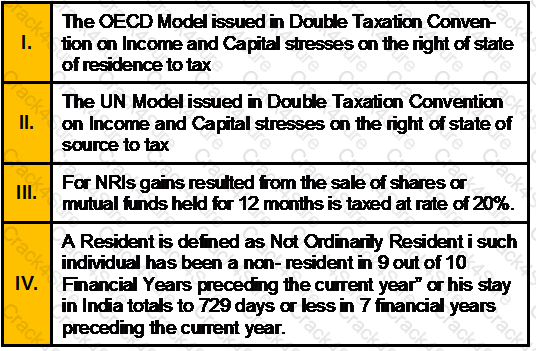
Section A (1 Mark)
Which of the following statements is/are correct with respect to naïve diversification?
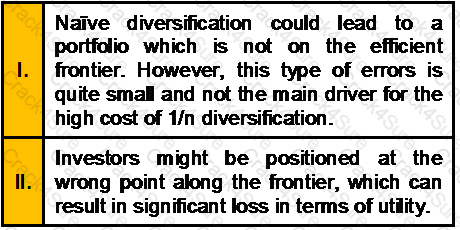
Section B (2 Mark)
Mr Dixit is considering purchasing an office building for Rs. 2,500,000. He expects the potential gross income (PGI) in the first year to be Rs. 450,000; vacancy and collection losses to be 9 percent of PGI; and operating expenses to be 42 percent of effective gross income (EGI). What is the (effective) gross income multiplier?
Section A (1 Mark)
Which of the following is a special human trait that we need to sharpen and use very often in CRM?
Section B (2 Mark)
Which of the following factors affect the price of a stock option?
Section C (4 Mark)
Consider a three-month futures contract on gold. The fixed charge is Rs.310 per deposit and the variable storage costs are Rs.52.5 per week. Assume that the storage costs are paid at the time of deposit. Assume further that the spot gold price is Rs.15000 per 10 grams and the risk-free rate is 7% per annum. What would the price of three month gold futures if the delivery unit is one kg? Assume that 3 months are equal to 13 weeks.
Section A (1 Mark)
Aditya’s father has given him general power of attorney what does this mean?
Section A (1 Mark)
Book building is used to help in better
Section B (2 Mark)
Mr. Ram buys 100 calls on a stock with a strike of Rs.1,200. He pays a premium of Rs.50/call. A month later the stock trades in the market at Rs.1,300. Upon exercise he will receive __________.
Section A (1 Mark)
Which one of the following equations correctly defines the dividend yield (Y) from a share of common stock?
Section B (2 Mark)
Mr. Manish purchased a residential house for Rs.3 lakh on 1-4-1972. Its market value on 1-4-1981 was, however, Rs.12 lakh. He sells the house during the financial year 2011-12 for Rs.98 lakh. Calculate the taxable long term capital gain.[CII-12-13: 852,11-12: 785,10-11:711]
Section A (1 Mark)
In Private Equity, the stage where the start-up company may starts generating profits in a quarter or so or be just at the point of breaking even is called_________________
Section C (4 Mark)
As a CWM you are required to calculate the tax liability of an individual whose taxable income is:
• $321500 in SGD and he is a Singapore citizen
• £ 35214p.a (only dividends) and he is a UK citizen
Section B (2 Mark)
Which of the following is an inferential data (i.e. data which may not be correctly obtained by simply asking a direct question)?
Section B (2 Mark)
PPF is a
Section A (1 Mark)
If an investor searches for patterns in security returns by examining various techniques applied to a set of data, this is known as:
Section C (4 Mark)
Mr. Amit Jain has bought a house today which cost him Rs. 50 lacs by taking a loan of 30lacs for 15 years at 11% per annum compounded monthly. He currently has 10 lacs of financial assets and plans to save Rs. 3.25 lacs every year at the beginning of the year for the next 5 years. All his investments are expected to grow at a ROI of 15%per annum compounded quarterly. What will be the net worth of Mr. Amit after 5 years if the value of the house after 5 years is expected to be 75 lacs.
Section C (4 Mark)
Allianz is a number one accredited institute for the Engineering in New Delhi. It pays dividend per share of Rs. 0.24 on reported earning per share of Rs. 0.512 in 2007. The firms earnings per share have grown at 8% over the prior 5 year but that growth rate is expected to decline linearly over the next 5 years to 3%, while the payout ratio remains unchanged. The beta for the stock is 0.9. The risk free rate is 4.2% and the market risk premium is 4%.Calculate the price of the stock.
Section A (1 Mark)
_______________ is concerned with capturing, storing, extracting, integrating, processing, interpreting, distributing, using and reporting customer-related data to enhance both customer and company value.
Section B (2 Mark)
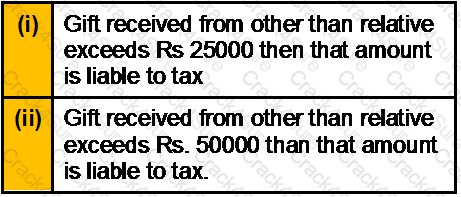
Which one of the above statements is/are incorrect?
Section B (2 Mark)
Which of the following is closest to the forward price of a share price if
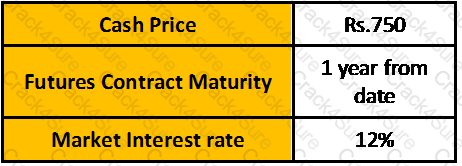
Dividend expected is 6%?
Section A (1 Mark)
The difference between the cash price and the futures price on the same asset or commodity is known as the
Section A (1 Mark)
Mr. X’s minor daughter earned Rs. 50000 from his special talent. This income will be clubbed with
Section A (1 Mark)
____________represents people’s propensity to claim an irrational degree of credit for their successes.
Section A (1 Mark)
______________ is a manifestation of mental accounting that can cause people to take on more risk as their wealth increases.
Section C (4 Mark)
What amount needs to be deposited today in an account that would pay Rs. 1,10,000 per year for the first 10 years and Rs. 2,25,000 for the next 5 years. If the ROI for the first 10 years if 10.75 % p.a. compounded annually and 13% p.a. compounded quarterly for the balance period?
Section C (4 Mark)
Read the senario and answer to the question.
Pallavi’s marriage is expected by the end of December, 2010 with an expected present cost of Rs. 24,00,000. He is expected to realize from his Tatanagar Flat 18, 00,000 by that time. Calculate what additional amount is required for his daughter’s marriage. With 8% pa. risk free rate compounding monthly what amount he has to save per month (BEGIN) in a debt fund?
Section A (1 Mark)
REITs offer all of these, except:
Section B (2 Mark)
The income of any university or other educational institution existing solely for educational purposes and not for the purposes of profit is exempt under clause (iiiad) of Section 10(23C) if the aggregate annual receipts’ of such university or educational institution do not exceed.
Section A (1 Mark)
Income received in India in previous year is taxable in the hands of:
Section B (2 Mark)
Akash has only compulsory third party policy for his car. He jumped a red light and collided with another car and then with the boundary wall of a nearby house. Damage to his car was of Rs. 17,000/-, damage to other car was of Rs. 15,000/- and damage to the boundary wall of house was of Rs. 15,000. The insurance policy of Akash will pay:
Section C (4 Mark)
The current dividend on an equity share of Bharat Limited is Rs.8.00 on earnings per share of Rs. 30.00. Assume that the dividend per share will grow at the rate of 20 percent per year for the next 5 years. Thereafter, the growth rate is expected to fall and stabilize at 12 percent. Investors require a return of 15 percent from Bharat’s equity shares. What is the intrinsic value of Bharat’s equity share?
Section A (1 Mark)
Which one of the following statements is/are true?
Section A (1 Mark)
Which of the following could be classified as an emotional bias?
Section A (1 Mark)
Merton’s theory is ___________
Section A (1 Mark)
Equifax Credit Report Contain
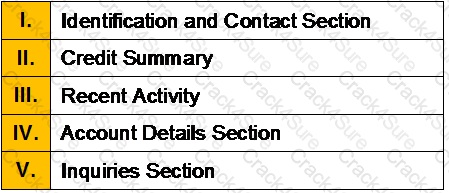
Section A (1 Mark)
Premium under endowment plans equals
Section A (1 Mark)
Wealth Conservation is _____________
Section A (1 Mark)
Multi period hedging is ________
Section B (2 Mark)
You are required to calculate standard deviation of the following portfolio

CovAB = 220.
Section B (2 Mark)
How much total principal is repaid between the 1st and 17th payment interval of a 4.5-year loan for Rs 4567 at an interest rate of 7.44% compounded monthly. The payments are also monthly.
Section A (1 Mark)
____________ is defined as a dollar per thousand dollars of assessed value of property and is used to calculate a property owner's tax bill.
Section A (1 Mark)
Following is/ are the component(s) of Personal Financial Statements
Section C (4 Mark)
An investor Mr. Dayal, executes a Long Strangle by buying a Rs. 4300 Nifty Put for a premium of Rs. 23 and a Rs 4700Nifty Call for Rs 43. The Nifty is at 4500
The Net Payoff of Long Strangle
• If Nifty closes at 4100
• If Nifty closes at 5300
Section A (1 Mark)
__________ organization try to segment their customers based on what product the customer purchased.
Section A (1 Mark)
The premise of behavioral finance is that
Section B (2 Mark)
An analyst expects a firm’s earning per share to grow at 8% per year. If the firm now earns Rs. 3.50 a share, its earnings per share five years from now are expected to be:
Section B (2 Mark)
An investor is bearish about ABC Ltd. and sells ten one-month ABC Ltd. futures contracts at Rs.5,00,000. On the last Thursday of the month, ABC Ltd. closes at Rs.510. He makes a _________. (assume one lot = 100)
Section B (2 Mark)
Shiva Industries Ltd. earns Rs. 2 per share and distributes 40% of its earnings as cash dividends. Its dividends grew annually at 7%. What will be the stock’s price if the required rate is 10%?
Section A (1 Mark)
________ bias means that investors are too slow in updating their beliefs in response to evidence.
Section C (4 Mark)
Read the senario and answer to the question.
What is the monthly extra saving at beginning required to be done by Raman during his remaining working period to accumulate his required retirement corpus?
Section A (1 Mark)
Convertible bond arbitrage is to event driven as _________ is to corporate restructuring.
Section A (1 Mark)
An arbitrage opportunity exists if an investor can construct a __________ investment portfolio that will yield a sure profit.
Section A (1 Mark)
A(n) _____________ is related to the credit option and is usually aimed at lenders able to handle comparatively limited declines in value but wants insurance against serious losses.
Section B (2 Mark)
The following parameters are available for two mutual funds:
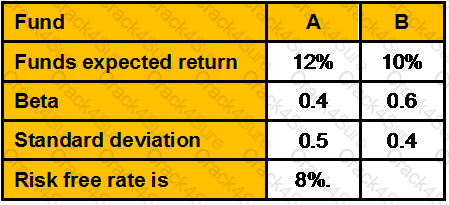
Calculate Treynor’s performance index for Fund A & Fund B respectively
Section C (4 Mark)
Consider the following information for three mutual funds
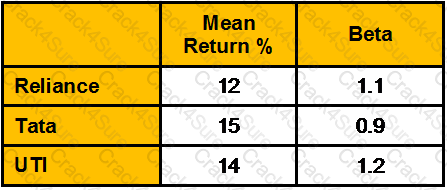
Risk free return is 7%. Calculate Treynor measure?
Section A (1 Mark)
Short-term to medium-term loans repayable in two or more consecutive payments are known as:
Section A (1 Mark)
Division of the market into groups based on variables such as age, gender, size, income, occupation, education, religion, race and nationality comes under which of the following market segmentation?
Section A (1 Mark)
A type of CRM Dominant characteristic which applies technology across organizational boundaries with a view to optimizing company, partner and customer value is known as_______________.
Section A (1 Mark)
A testamentary trust is affected after the
Section B (2 Mark)
____________ are good examples of the limits to arbitrage because they show that the law of one price is violated.
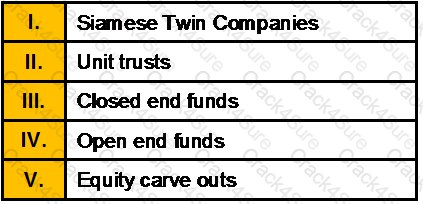
Section A (1 Mark)
Which one of the following statements is false?
Section B (2 Mark)
NRIs are granted a special benefit by way of an option of being taxed at concessional tax rate of ________ as regards "investment income" and _______ as regards "long term capital gains" arising from "specified assets.
Section A (1 Mark)
If the proposer does not disclose fully all the material facts at the time of Proposal the principle violated
Section A (1 Mark)
Notice of loss should be given to the insurer within ________days of the event of loss.
Section C (4 Mark)
As a CWM you are required to calculate the tax liability of an individual whose Taxable income is:
• $ 142700 in US dollars and he is a US citizen (married Individual Filing Joint returns and Surviving Spouses)
• $ 67250 in SGD and he is a citizen of Singapore
Section B (2 Mark)
Money kept in current account normally earns
Section A (1 Mark)
Which of the following is true regarding the resistance level?
Section B (2 Mark)
Defined contribution plans put investment and performance risk on
Section B (2 Mark)
In the calculation of rates of return on common stock, dividends are _______ and capital gains are _____.
Section B (2 Mark)
Gold trades at Rs.16000 per 10 gms in the spot market. Three-month gold futures trade at Rs.16150. One unit of trading is 1kg and the delivery unit for the gold futures contract on the NCDEX is 1 kg. A speculator who expects gold prices to rise in the near future buys 1 unit of gold futures. Two months later gold futures trade at Rs.15900 per 10 gms. He makes a profit/loss of ______________.
Section B (2 Mark)
Withholding Tax Rates for payments made to Non-Residents are determined by the Finance Act passed by the Parliament for various years. The current rates for Royalities are:
Section A (1 Mark)
_______________ and _______________ mandates are two kinds of service level contracts
Section C (4 Mark)
Read the senario and answer to the question.
Mr. Bhatia owns a Maruti Wagonr with a monthly EMI of Rs. 6,312. The above loan will be completely repaid by August 2008. Mr. Bhatia planning to purchase a new car worth of Rs. 15 lakh. For this he has to take a full value loan of the car with 9% interest for 5 years. But his present car is in good condition and life of this car is approximately another 5 years repairs and maintenance cost are minimum. If he postpones his car purchasing plan now and deposit the same EMI outflow required for new car into an SIP with a minimum 15% yield for the next five years, then calculate the fund he can accumulate?
Section A (1 Mark)
Which of the following types of income is received by individuals without deduction of basic rate tax?
Section C (4 Mark)
Asit an industrialist wants to buy a car presently costing Rs. 10,00,000/- after 5 years. The cost of the car is expected to increase by 10% p.a for the first 3 years and by 6% in the remaining years. Asit wants to start a SIP with monthly contributions in HDFC Top 200 Mutual Fund. You as a CWM expect that the fund would give an average CAGR of 12% in the next 5 years. Please advise Asit the monthly SIP amount starting at the beginning of every month for the next 5 years to fulfill his goal of buying the Car he desires.
Section A (1 Mark)
Which of the following statement is/are true?
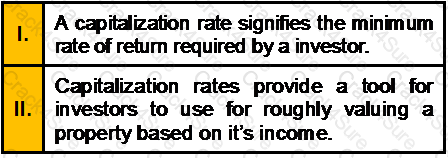
Section A (1 Mark)
A forward contract differs from a futures contract in that:
Section A (1 Mark)
In a life insurance contract, offer refers to
Section A (1 Mark)
A good customer relationship management program will allow a business to:
Section B (2 Mark)
The _________ is a plot of __________.
Section B (2 Mark)
The Dow theory illustrates that the three forces that simultaneously affect stock prices are ____________.
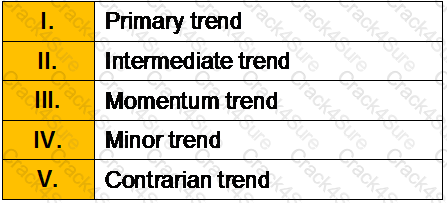
Section A (1 Mark)
Monetary policy is determined by
Section C (4 Mark)
Mr. XYZ is bullish about ABC Ltd stock. He buys ABC Ltd. at current market price of Rs. 4000 on 4th July. To protect against fall in the price of ABC Ltd. (his risk), he buys an ABC Ltd. Put option with a strike price Rs. 3900 (OTM) at a premium of Rs. 143.80 expiring on 31st July.
What would be the Net Payoff of the Strategy?
• If ABC Ltd closes at 3458
• If ABC Ltd closes at 4352
Section A (1 Mark)
Mansi deposits Rs. 50,000/- in a bank account which pays interest @ 10 % per annum. How much can be withdrawn at the beginning of each year for 5 years if first withdrawal is 6 years from now?
Section B (2 Mark)
Expenses are 10% of the gross (office) premium. Pure premium is Rs. 200. Calculate office premium.
Section B (2 Mark)
Which of the following are the ways to avoid escalation of commitment are listed below?
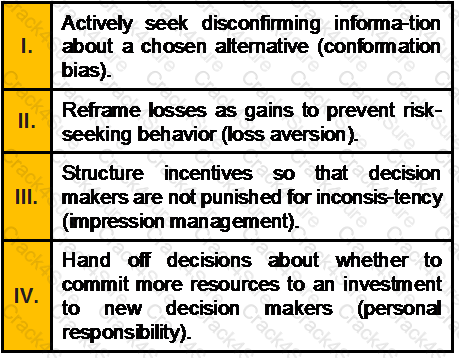
Section C (4 Mark)
Mr. XYZ sells a Nifty Put option with a strike price of Rs. 4000 at a premium of Rs. 21.45 and buys a further OTM Nifty Put option with a strike price Rs. 3800 at a premium of Rs. 3.00 when the current Nifty is at 4191.10, with both options expiring on 31st July.
What would be the Net Payoff of the Strategy?
• If Nifty closes at 3980.55
• If Nifty closes at 4800
Section A (1 Mark)
Mr. Murli is 55 years old at present. He has invested some amount in an annuity which will pay him begining of the 5th year Rs. 30,000/- p.a. at the beginning of every year for 10 years. Rate of interest is 7% p.a. Calculate how much amount he has invested now?
Section A (1 Mark)
Tarun has Rs. 100000/- in a account and starts investing Rs. 7500/-per month at the beginning of the month. If the account pays 10% p.a interest compounded half yearly. What will be the accumulated amount in his account after 20 years.
Section A (1 Mark)
A bank is considering making a loan to Neelam Pandey. The bank is looking at her credit report from Equifax and also examining the reason Neelam has put on the loan application for needing the loan? What aspect of evaluating a consumer loan application is the bank looking at?
Section B (2 Mark)
The Motor Vehicle Insurance Policy has inbuilt cover for death/disability of driver/owner caused by accident during the use of the insured motor vehicle up to Rs. __________ in case of car/commercial vehicle and Rs. _________ in case of two wheelers.
Section C (4 Mark)
Management has recently announced that expected dividends for the next three years will be as follows:
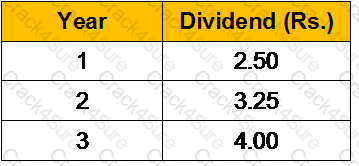
For the subsequent years, management expects the dividend to grow at 5% annually. If the risk-free rate is 4.30%, the return on the market is 10.30% and the firm’s beta is 1.40. What is the maximum price that you should pay for this stock?
Section B (2 Mark)
___________, the net profit margin realized by the enterprise from an international transaction entered into with an associated enterprise is computed in relation to cost incurred or sales affected or assets employed or to be employed in the enterprise or having regard to any relevant base.
Section C (4 Mark)
OHM Corporation, an environmental service provider, had revenues of Rs209 million in 1992 and reported losses of Rs3.1 million. It had earnings before interest and taxes of Rs12.5 million in 1992, and had debt outstanding of Rs109 million (in market value terms). There are 15.9 million shares outstanding, trading at Rs11 per share. The pre-tax interest rate on debt owed by the firm is 8.5%, and the stock has a beta of 1.15. The firm's EBIT is expected to increase 10% a year from 1993 to 1996, after which the growth rate is expected to drop to 4% in the long term. Capital expenditures will be offset by depreciation, and working capital needs are negligible. (The corporate tax rate is 40%, and the Risk free rate is 7%.)
Estimate the value of the firm.
Section B (2 Mark)
You write one XYZ February 50 put for a premium of Rs5. Ignoring transactions costs, what is the breakeven price of this position?
Section B (2 Mark)
The Wilson Corporation has the following relationships:

What is Wilson’s profit margin and debt ratio?
Section C (4 Mark)
Read the senario and answer to the question.
Mrs. Deepika’s brother is impressed with Manav Fashion Ltd. an online clothing firm that focuses on the 18–22 age bracket. Their prices are much lower than their competitors, and the quality is high. Reading about the firm on its web site and in various financial newspapers, her brother has learned that the company plans to expand its clothing lines. The prevailing price of its share is 70 per share. Manav Fashion Ltd. has had recent annual earnings of Rs. 5 per share. Only three other companies have very similar business to Manav Fashion Ltd. and have stock that is traded and there PE ratios are as follows:
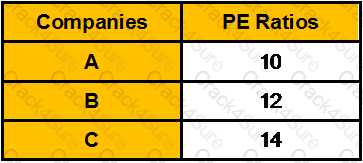
Her brother asked Mrs. Deepika to guide him in investing the Manav Fashion Ltd. Getting the query from her brother Mrs. Deepika asks your advice on this matter. As a Chartered Wealth Manager what will be your advice?
Section B (2 Mark)
The expected market return is 16 percent. The risk-free rate of return is 7 percent, and BC Co. has a beta of 1.1. Their required rate of return is
Section A (1 Mark)
The borrower's attitude toward his or her credit obligations is called:
Section B (2 Mark)
A taxpayer has taxable income for 2011-12 (after deducting the personal allowance) of £75,200. None of the income is derived from savings or dividends. The income tax liability for the year is:
Section A (1 Mark)
As per presumptive income scheme under section 44AE, the presumed income shall be:
Section B (2 Mark)
Equity stock of X ltd. is currently selling at Rs. 35/- per share. The dividend expected next year is Rs. 2/- per share and the investor’s required return in this stock is 15 % per annum. If the constant Growth Model applies to X ltd. then calculate the Growth Rate.
Section A (1 Mark)
Manoj owns five hundred shares of ABC Ltd. Around budget time, he gets uncomfortable with the price movements. Which of the following will give him the hedge he desires (assuming that one futures contract = 100 shares) ?
Section C (4 Mark)
The required rate of return on an investment is 12%, you estimate that a firm X’s dividend will grow as follows:
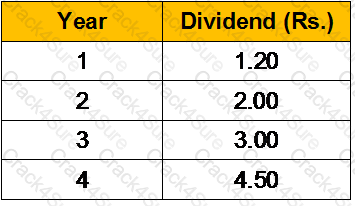
For the subsequent years you expect the dividend to grow at the more modest rate of 7% annually. What is the maximum price that you should pay for this stock?
Section C (4 Mark)
Suppose that an investor makes an investment in Stock ABC and that over the next 12 months ABC appreciates by 10 percent. He then thinks of selling ABC for normal portfolio rebalancing purposes, but then come across an item in the, The Economic Times that sparks new optimism: Could ABC climb even higher?
Which answer describes the likeliest response from an investor with regard to exhibiting Regret Aversion Bias, given ABC’s recent performance and this new information?
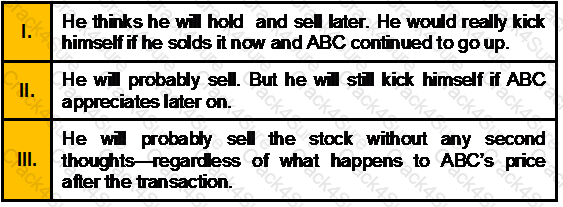
Section C (4 Mark)
Mr. Peter sells a Nifty Put option with a strike price of Rs. 4000 at a premium of Rs. 21.45 and buys a further OTM Nifty Put option with a strike price Rs. 3800 at a premium of Rs. 3.00 when the current Nifty is at 4191.10, with both options expiring on 31st July.
What would be the Net Payoff of the Strategy?
• If Nifty closes at 3800
• If Nifty closes at 4500
Section B (2 Mark)
If JVM Industries pays dividend of Rs.6 per share which is growing at a 8 percent rate per year and is expected to grow at the same rate in future. Its required rate of return is 16%. Determine its share price.
Section B (2 Mark)
Which of the following statements concerning index funds and actively managed funds is true?
Section A (1 Mark)
Financial Independence usually occurs between _______
Section B (2 Mark)
Resident but not ordinary resident (RNOR) is ____________ on Indian Income and ___________ on Foreign Income.
Section A (1 Mark)
Which one of the following has not caused the huge growth in hedge funds and private equity?
Section A (1 Mark)
A firm has a higher asset turnover ratio than the industry average, which implies
Section A (1 Mark)
Mr.Gopal is working in a reputed company and earning Rs. 3,00,000/- p.a. and is now 48 years old. He has invested Rs. 3,00,000/- in an annuity which will pay him after 5 years a certain amount p.m. at the end of every month for 10 years. Rate of interest is 8% p.a. Calculate how much he will receive at the end of every month after 5 years?
Section B (2 Mark)
Withholding Tax Rates for payments made to Non-Residents are determined by the Finance Act passed by the Parliament for various years. The current rates for Interest are:
Section A (1 Mark)
A bank that wants to protect itself from higher credit costs due to a decrease in its credit rating might purchase _________________________.
Section A (1 Mark)
One aspect of the tax considerations in asset allocation is that
Section A (1 Mark)
The covariance of the market returns with the stocks returns is 0.008. The standard deviation of the market is 8% and standard deviation of stock’s return is 11%. What is the correlation coefficient between stocks and market returns?
Section C (4 Mark)
Suppose Nifty is at 4450 on 27th April. An investor, Mr. A enters a long straddle by buying a May Rs 4500 Nifty Put for Rs. 85 and a May Rs. 4500 Nifty Call for Rs. 122.
What would be the Net Payoff of the Strategy?
• If Nifty closes at 3729
• If Nifty closes at 5214
Section A (1 Mark)
Which of the following is not a broad category of Alpha drivers?
Section B (2 Mark)
Manav invests Rs. 500/- every 6 months towards a fund to pay for his children education. If the investment pays ROI @ 9 % per annum, compounded Semi Annually, then what will be the corpus after 10 years ?
Section A (1 Mark)
AUM stands for
Section C (4 Mark)
Read the senario and answer to the question.
Calculate the retirement corpus required by Raman to generate his post-retirement expenses.
Section B (2 Mark)
Total income of an individual including long-term capital gain of Rs. 50,000/- is Rs.1,60,000/-, the tax on total income for the assessment year 2012-13 shall be: CII-12-13: 852,11-12: 785,10-11:711]
Section A (1 Mark)
Comprehensive Wealth Management addresses
Section B (2 Mark)
Vikrant Juneja gifted his house property to his wife in year 2007. Mrs. Juneja then lets out this house @ Rs. 5000 per month. The income from such house property will be taxable in the hands of:
Section B (2 Mark)
A bank has a long term relationship with a particular business customer. However, recently the bank has become concerned because of a potential deterioration in the customer's income. In addition, regulators have expressed concerns about the bank's capital position. The business customer has asked for a renewal of its Rs25 million dollar loan with the bank. Which credit derivative can help this situation?
Section B (2 Mark)
Which of the following statements is/are correct with respect to Resident Very Senior Citizen i.e. who is of an age of 80 years and above?
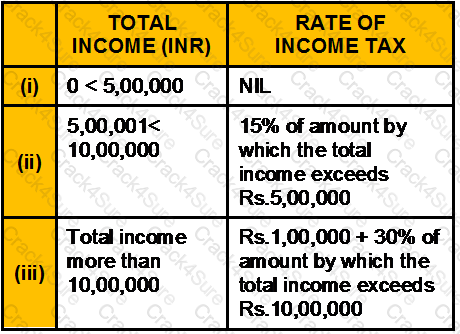
Section A (1 Mark)
In terms of the risk/return relationship
Section C (4 Mark)
Suppose ABC Ltd. is trading at Rs. 4457 in June. An investor Mr. A buys a Rs 4500 call for Rs. 100 while shorting the stock at Rs. 4457. The net credit to the investor is Rs. 4357
What would be the Net Payoff of the Strategy?
• If ABC Ltd closes at 4145
• If ABC Ltd closes at 4983
Section B (2 Mark)
If a stock GHI ltd pays an annual dividend of Rs. 5 and plans to follow this policy for ever, then what would be the ate of return that investor would realize given the current market price of stock is 100?
Section B (2 Mark)
Asset allocation policy

Section A (1 Mark)
__________ is the most important investment decision because it determines the risk-return characteristics of the portfolio.
Section A (1 Mark)
A trough is ________.
Section A (1 Mark)
The________________ deals with the double-edged enigma of why individuals like dividends (in developed country where dividends are taxable) and why this method of income distribution persists in light of quite burdensome double taxation.
Section A (1 Mark)
A(n) _________________________ guarantees the swap parties a specific rate of return on their credit asset. Bank A may agree to pay the total return on the loan to Bank B plus any appreciation in the market value of the loan. In return Bank A will often get LIBOR plus a fixed spread plus any depreciation in the value of the loan.
Section B (2 Mark)
Compulsory maintenance of account is required u/s 44AA of IT, if the gross receipt/ total sales exceed _______
Section A (1 Mark)
In “CAMPARI” Model, R stands for:
Section A (1 Mark)
__________ is a tangible company asset that can (and should) be inventoried and managed.
Section C (4 Mark)
Read the senario and answer to the question.
Calculate the income from house property for Vinay. Municipal rental value 75000, Fair Rental value is 80000, Standard rent is 1,10,000. Municipal taxes paid for full house are Rs. 10,000 during the year. Interest paid by Vinay on borrowed money during the year is Rs. 101070.
Section A (1 Mark)
_______________ and _______________ mandates are two kinds of service level contracts
Section A (1 Mark)
Psychologists have found that people who make decisions that turn out badly blame themselves more when that decision was unconventional. The name for this phenomenon is
Section C (4 Mark)
As a CWM you are required to calculate the tax liability of an individual whose taxable income is:
• $ 81250 in SGD and he is a Singapore citizen
• £ 67158p.a (only employment)and he is a UK citizen
Section B (2 Mark)
Last year, Owen Technologies reported negative net cash flow and negative free cash flow. However, its cash on the balance sheet increased. Which of the following could explain these changes in its cash position?
Section A (1 Mark)
A(n) __________________ guards against the losses in the value of a credit asset. It would pay off if the asset declines significantly in value or if it completely turns bad.
Section B (2 Mark)
The ____________ provides an unequivocal statement on the expected return-beta relationship for all assets, whereas the _____________ implies that this relationship holds for all but perhaps a small number of securities.
Section C (4 Mark)
Omax Inc. one of the largest developer of residential projects, reported earnings per share of Rs 8.0 in 2003, and paid dividends per share of Rs 4.8 in that year. The firm is expected to report earnings growth of 25% in 2004, after which the growth rate is expected to decline linearly over the following six years to 7% in 2009. The stock is expected to have a beta of 0.85 and current risk free rate is 6.25%.
Estimate the value of the firm using the H Model.
Section B (2 Mark)
Payback period is
Section A (1 Mark)
Retiring early will need
Section C (4 Mark)
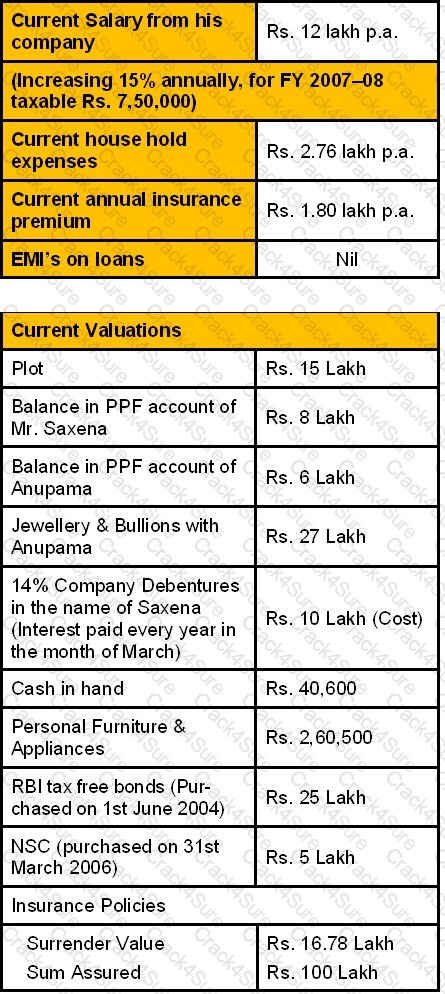 Mr. Saxena, age 45 years, is a software engineer and promoter of an Indian MNC. His family comprises his wife Anupama, age 43 years, who is a house wife, elder son Arup, 16 years (studying in 10th standard) and daughter Aarti, 14 years (studying in 8th standard). The family resides in their self owned residential house in Mumbai. Most of their life amenities such as cars, abroad vacations and full education cost of both kids are provided by Mr. Saxena’s company, as he is the Managing Director of his company. The company is growing consistently and is on way to become a global legend in its field of operations. As such the future prospects of Mr. Saxena are generous and progressive.
Mr. Saxena, age 45 years, is a software engineer and promoter of an Indian MNC. His family comprises his wife Anupama, age 43 years, who is a house wife, elder son Arup, 16 years (studying in 10th standard) and daughter Aarti, 14 years (studying in 8th standard). The family resides in their self owned residential house in Mumbai. Most of their life amenities such as cars, abroad vacations and full education cost of both kids are provided by Mr. Saxena’s company, as he is the Managing Director of his company. The company is growing consistently and is on way to become a global legend in its field of operations. As such the future prospects of Mr. Saxena are generous and progressive.
Mr. Saxena is now planning to allocate his resources in the right fashion with your help as a Chartered Wealth Manager.
For this, he has disclosed his current personal financial details as follows:

Other details for FY 2007–08
1.Mr. Saxena has made investments worth Rs. 1.50 Lakh qualified U/S 80C.
2.He has donated Rs. 50,000 to Prime Ministers National Relief Fund.
3.He has transferred interest received by him on debentures to his wife’s bank account the same date he received it.
4.Mr. Saxena’s minor son, Arup, is a recognized child artist in children cinema and documentary films. Arup earned a sum of Rs. 1,50,000 from his assignments.
Mr. Saxena wants to resolve all estate bequeathing matters in his life time so that there should be no dispute after his death. For this purpose he has prepared a “Holograph Will”.
Current estimates of economy are positive and interest rates are not likely to increase further in near future. The family has a health cover provided by the company of Mr. Saxena. Also his house with all its contents is insured adequately.
Section A (1 Mark)
A firm in an industry that is very sensitive to the business cycle will likely have a stock beta ___________.
Section B (2 Mark)
The current market price of a share of JVJ stock is Rs60. If a put option on this stock has a strike price of Rs55, the put
Section B (2 Mark)
There are two parties to Power of Attorney, namely, Donor and Donee.

Section A (1 Mark)
Guarantees covering security deposit/earnest money/advance payment/ mobilization advance etc. would come under__________________ category
Section A (1 Mark)
Following is not a head of income
Section A (1 Mark)
As per Hindu succession Act 1956 following person is not considered as a class I heir of the person who dies intestate
Section B (2 Mark)
Mr. Jain is projecting an income stream providing Rs. 2,000/- for first 3 months, Rs. 3,200 for next 2 months, Rs. 4,500 for next 1 month, Rs. 3,700 for next 6 months and Rs. 800 for 2 months thereafter. EACH CASH FLOW starts from the beginning of the month. Please calculate the Present Value of this cash stream if rate of interest is 9 % per annum compounded monthly?
Section A (1 Mark)
____________ may be responsible for the prevalence of active versus passive investments management.
Section A (1 Mark)
After the satisfaction of insured’s claim from the insurer, the insured should pursue in the recovering of rights from the 3rd party.
Section C (4 Mark)
Mr. XYZ buys a Nifty Call with a Strike price Rs. 4100 at a premium of Rs. 170.45 and he sells a Nifty Call option with a strike price Rs. 4400 at a premium of Rs. 35.40.
What would be the Net Payoff of the Strategy?
• If Nifty closes at 4343
• If Nifty closes at 3419
Section B (2 Mark)
If two customers choose exactly the same package of certain service, but customer A calls for help weekly and customer B calls only twice a year, which is most valuable customer?
Section A (1 Mark)
In case of Credit Assessment, if the lender accepts the application and takes it forward towards acceptance provided it passes through the risk assessment criterion, then the Credit Score Band of the borrower would be:
Section A (1 Mark)
___________is concerned with the rational solution to the problem at hand. It defines an idea that actual decisions should strive to approximate.
Section A (1 Mark)
A bank is considering making a loan to Sumit Nayyar. Mr. Sumit has Rs 1,00,000 in the bank right now but generally keeps a balance of Rs 4,50,000 most of the year. What aspect of evaluating a consumer loan application is this fact concerned with?
Section A (1 Mark)
Correlate, combine, cognize and __________ are the four C’s of CRM Process
Section C (4 Mark)
A firm has a P/E ratio of 12 and a ROE of 13% and a market to book value of __________.
Section A (1 Mark)
A(n) _________________________ occurs when two banks agree to exchange a portion or all of the loan repayments of their customers.
Section A (1 Mark)
_________________ is a method to evaluate a large volume of consumer loans quickly with minimum labor. This method is a statistical model which predicts whether the consumer will repay the loan or not.
Section B (2 Mark)
As per Article 11 double Taxation Avoidance Agreement with US Interest arising in a Contracting State and paid to a resident of the other Contracting State may be taxed in that other State.However, such interest may also be taxed in the Contracting State in which it arises, and according to the laws of that State, but if the beneficial owner of the interest is a resident of the other Contracting State, the tax so charged shall not exceed:
(a) ____per cent of the gross amount of the interest if such interest is paid on a loan granted by a bank carrying on a bona fide banking business or by a similar financial institution (including an insurance company); and
(b) _____ per cent of the gross amount of the interest in all other cases.
Section B (2 Mark)
Which of the following statements is/are correct with respect for Resident Senior Citizen i.e. who is of an age of 60 years and above, but below 80 years?
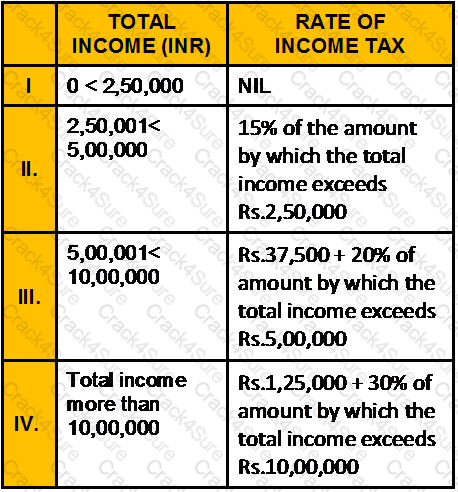
Section A (1 Mark)
Your client Mr. Singhania expressed his intention to write his will in his own handwriting such a will which is wholly in the handwriting of the testator is renown as:
Section A (1 Mark)
Which of the following statements least accurately describes a form of risk associated with investing in fixed income securities?
Section A (1 Mark)
A good wealth management plan must include an analysis of all of the following EXCEPT
Section B (2 Mark)
As per Double Taxation Avoidance Agreement, the Royalties in UAE is charged at:
Section A (1 Mark)
A rapidly growing GDP indicates a(n) ______ economy with ______ opportunity for a firm to increase sales.
Section C (4 Mark)
Watts Industries, a manufacturer of valves for industrial and residential use, had the following projected free cash flows to equity per share for the next five years , in nominal terms.
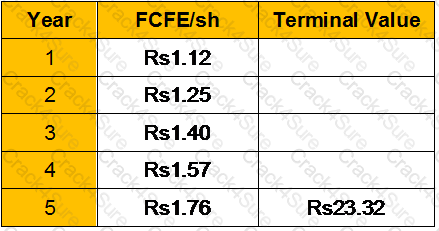
The terminal price is based upon a stable nominal growth rate of 6% a year after year 5. The discount rate, based upon financial market rates, is 14%, and the expected inflation rate is 3%.
Estimate the value per share, using nominal cash flows and the nominal discount rate.
Section A (1 Mark)
Credit cards are the best example of a _____________ that offer consumers convenience and flexibility.
Section B (2 Mark)
Assume that you purchased 100 shares of ABC in a self directed account and paid a commission on the transaction. Shortly following the purchase, you realize that you momentarily overlooked another 100 shares of ABC that you already owned in another account. Now, the redundant holdings are causing an imbalance in your overall portfolio.
What is your reaction to this situation, in case of Endowment Bias?
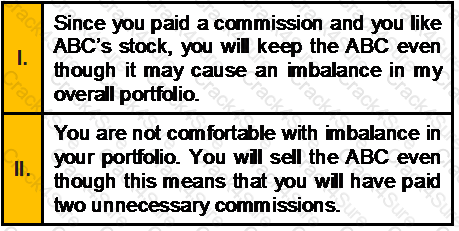
Section C (4 Mark)
Mr. Rajesh Rawat deposits Rs. 15,000 per month at the end of the month for 6.50 years in an account that pays a ROI of 8.80% per annum compounded quarterly. What will be the amount in the account after 6.50 years?
Section B (2 Mark)
For calculation of liability of payment of gratuity to an employee on leaving service, the wage to be taken into account is
Section B (2 Mark)
Fiscal policy generally has a _______ direct impact than monetary policy on the economy, and the formulation and implementation of fiscal policy is ______ than that of monetary policy.
Section B (2 Mark)
Mr. L Singh used machinery in his business. This is the only asset in the block. 20% of the usage is for personal purposes. The WDV of the block as on 31.3.2011 is —
Section A (1 Mark)
Which of the following industry categories is said to be “bought to be sold?”
Section B (2 Mark)
Which of the following two outcomes is an example of Loss Aversion Bias:

Section B (2 Mark)
As per article 11 Double Taxation Avoidance Agreement with UAE, Interest arising in a Contracting State and paid to a resident of the other Contracting State may be taxed in that other State. However, such interest may be taxed in the Contracting State in which it arises and according to the laws of that State, but if the recipient is the beneficial owner of the interest, the tax so charged shall not exceed:
(a) _______ percent of the gross amount of the interest if such interest is paid on a loan granted by a bank carrying on a bona fide banking business or by a similar financial institution; and
(b) _______ percent of the gross amount of the interest in all other cases.
Section A (1 Mark)
A “Family Office” segment client has investible assets worth of
Section A (1 Mark)
The two components of EPS are
Section A (1 Mark)
_______________ consists of the constatation that people buy both insurances and lottery tickets .
Section B (2 Mark)
Reproduction cost has been estimated as Rs 350,000 for a property with a 70-year economic life. The current effective age of the property is 15 years. The value of the land is estimated to be Rs 55,000. What is the estimated market value of the property using the cost approach, assuming no external or functional obsolescence?
Section B (2 Mark)
An investor is bearish about Tata Motors and sells ten one-month ABC Ltd. Futures contracts at Rs.6,06,000. On the last Thursday of the month, Tata Motors closes at Rs.600. He makes a _________. (assume one lot = 100)
Section A (1 Mark)
Which of the following statement is true?
Section B (2 Mark)
Suppose you have some money to invest and you hear about a great stock tip from your neighbor who is known to have a good stock market sense. He recommends you purchase shares in Petrolite, a company that makes a new kind of lighter fluid for charcoal grills.
What is your response to this situation if you exhibit Availability bias?
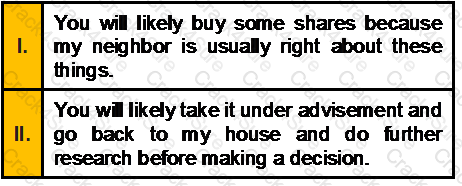
Section B (2 Mark)
If an investor determines that next year’s earnings estimate is Rs2.00 per share and the company subsequently falters, the investor may not readjust the Rs2.00 figure enough to reflect the change because he or she is “anchored” to the Rs2.00 figure. This is not limited to downside adjustments—the same phenomenon occurs when companies have upside surprises
Which of the following Biases have been exhibited by the investor?
Section A (1 Mark)
The steps to establishing an investment policy are to state the
Section A (1 Mark)
The principle of _____________ ensures that an insured does not profit by insuring with multiple insurers
Section C (4 Mark)
Read the senario and answer to the question.
Assuming his son gets average marks in class 10th when he was just 15 years old, his father decided to send him abroad for further studies at age 21.calculate the amount that Mr. Mehta requires to invest in excess of the amount accumulated in previous question during next six years to accumulate a fund of Rs. 500000?
Section A (1 Mark)
Mr. Naresh is working in a reputed company and earning Rs. 5,00,000/- p.a. and is now 50 years old. He has invested Rs. 2,50,000/- in an annuity which will pay him after 5 years a certain amount p.a. at the end of every year for 10 years. Rate of interest is 8% p.a. Calculate how much he will receive at the end of every year after 5 years?
Section B (2 Mark)
The Sachdeva family includes a financially well-informed couple, both aged thirty-two, and two children aged four and six. They are financially sound, but were not in the market during the bull market of the 2003 to 2007 as many of their neighbors were. The couple’s total income, Rs.12,00,000 which is not expected to grow significantly. They have saved Rs.15,00,000, which they hope will be the financial foundation from which they will send their children to college and retire comfortably. The Sachdeva’s suffer from:
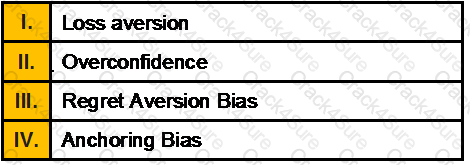
Section B (2 Mark)
In US, all states except _________________ require their state, via state constitutional or statutory requirements, to balance their budget.
Section C (4 Mark)
Suppose an investor Mr. A buys or is holding ABC Ltd. currently trading at Rs. 4758. He decides to establish a collar by writing a Call of strike price Rs. 5000 for Rs. 39 while simultaneously purchasing a Rs. 4700 strike price Put for Rs. 27. Since he pays Rs. 4758 for the stock ABC Ltd., another Rs. 27 for the Put but receives Rs. 39 for selling the Call option, his total investment is Rs. 4746.
What would be the Net Payoff of the Strategy?
• If ABC Ltd closes at 4851
• If ABC Ltd closes at 5267
Section A (1 Mark)
Which one of the above statements is/are not a important needs of clients in the context of relationship management:
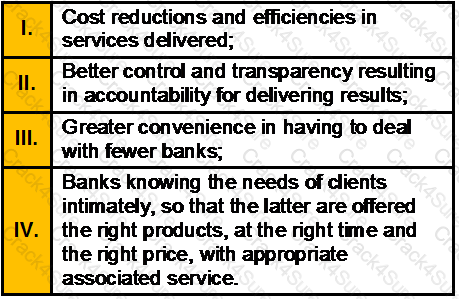
Section A (1 Mark)
____________means that people resist inequitable outcomes; i.e., they are willing to give up some material payoff to move in the direction of more equitable outcomes.
Section A (1 Mark)
A cognitive heuristic in which people tend to reach conclusions based on the 'framework' within which a situation is presented; e.g. people are more lokely to recommend the use of a new procedure if it is described as having a '50% success rate' than a '50% failure rate'. Which of the following is most likely consistent with this bias?
Section A (1 Mark)
Which one of the following statements is untrue?
Section A (1 Mark)
Which of the following is NOT a dimension of service quality?
Section C (4 Mark)
KB, a household product manufacturer, reported earnings per share of Rs3.20 in 1993, and paid dividends per share of Rs1.70 in that year. The firm reported depreciation of Rs315 million in 1993, and capital expenditures of Rs475 million. (There were 160 million shares outstanding, trading at Rs51 per share.) This ratio of capital expenditures to depreciation is expected to be maintained in the long term. The working capital needs are negligible. KB had debt outstanding of Rs1.6 billion, and intends to maintain its current financing mix (of debt and equity) to finance future investment needs. The firm is in steady state and earnings are expected to grow 7% a year. The stock had a beta of 1.05. (The Risk Free Rate is 6.25%.)
Estimate the value per share, using the FCFE Model.
Section B (2 Mark)
A bond has the following terms:

If you expect the bond to be called at the end of the year, what would be the maximum price you should pay for the bond if comparable yields are 7 percent?
Section C (4 Mark)
Company A is financed with 90 percent debt, whereas Company B, which has the same amount of total assets, is financed entirely with equity. Both companies have a marginal tax rate of 35 percent. Which of the following statements is most correct?
Section A (1 Mark)
A good example of closed-end credit is:
Section C (4 Mark)
Read the senario and answer to the question.
In order to provide for Medical Education Expenses of Navneet he will be transferring whole of Equity share portfolio to Debt MF. And for Yogita’s PG degree he is ready to use his Equity MF portfolio. Balance to be met by SIP in equity MF. Starting from today. You are required to guide Keshav whether he will be able to meet Navneet’s Education Expand what is the surplus or deficit in Debt MF (today value). And what should be the SIP amount for Yogita’s Education goal?
Section A (1 Mark)
Given below is the portfolio return; calculate the expected portfolio rate of return:
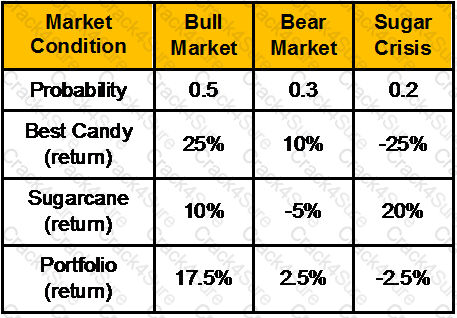
Section C (4 Mark)
Pinnacle India Ltd, reported a net profit of Rs1.085 billion on sales of Rs7.425 billion in 1993. The sales/book value ratio in 1993 was approximately 1.2, and the dividend payout ratio was 20%. The book value per share was Rs19 in 1993. The firm is expected to maintain high growth for ten years, after which the growth is expected to drop to 6%, and the dividend payout ratio is expected to increase to 65%. The beta of the stock is 1.05. (The treasury bill rate is 7%.)
Estimate the price/sales ratio for the company.
Section A (1 Mark)
Which of the following comes at the high end of product margin in the value added pyramid of wealth management?
Section A (1 Mark)
Monitoring and rebalancing a portfolio over time involves all of the following costs EXCEPT
Section C (4 Mark)
Read the senario and answer to the question.
Whether Mrs. Deepika as a resident individual can invest in units of Mutual Funds, Venture Funds, and Promissory notes without opening the bank account in foreign country?
Section A (1 Mark)
A cognitive heuristic in which decisions are made based on an initial 'anchor__________
Section A (1 Mark)
An Agreement between the tenant and the landlord for the right to use the property for a specified period of time is known as ____________.
Section B (2 Mark)
EDLI stands for
Section C (4 Mark)
Which of the following statements is/are correct?
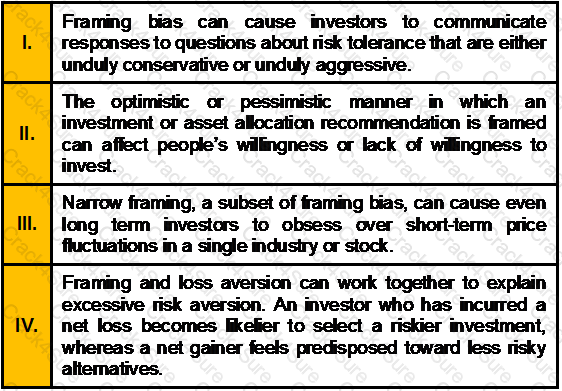
Section C (4 Mark)
Read the senario and answer to the question.
Which types(s) of investment(s), would be consistent with their retirement goal?
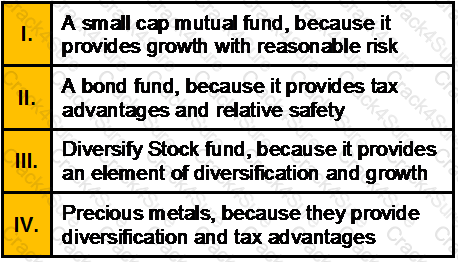
Section A (1 Mark)
What is the Present Value of an annuity which pays Rs. 10,000/- for 3 years at the END of each year, assuming ROI @ 7% per annum compounded annually?
Section B (2 Mark)
Mrs. Sharma, a 40-year-old widow, has an 8-year-old son. Her current savings are not adequate to provide for her son’s post graduate studies, however she will be able to save for it by the time he finishes graduation i.e. when he is 20 years old. Mortality tables indicate that her life expectancy is another 30 years.
Which one of the following is true?
Section C (4 Mark)
Read the senario and answer to the question.
Calculate income from House property for Mr. Keshav for assessment year 2010-11.
Section B (2 Mark)
Calculate the standard deviation on a portfolio from the following data
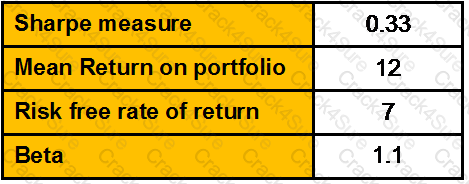
Section B (2 Mark)
You purchased one XYZ March 50 call and sold one XYZ March 55 call. Your strategy is known as
Section A (1 Mark)
The difference between a wagering contract and insurance contract is ___________.
Section C (4 Mark)
As a CWM you are required to calculate the tax liability of an individual whose Taxable income is:
• $ 178650 in US dollars and he is a US citizen (single individual)
• $ 85300 in SGD and he is a citizen of Singapore
Section A (1 Mark)
_____________allow investors to increase diversification in direct real estate holdings by investing in groups of real estate projects.
Section B (2 Mark)
You purchase one ILM 70 call option for a premium of Rs6. Ignoring transaction costs, the break-even price of the position is
Section B (2 Mark)
Which of the following statements with respect to Transfer Pricing is/are correct?
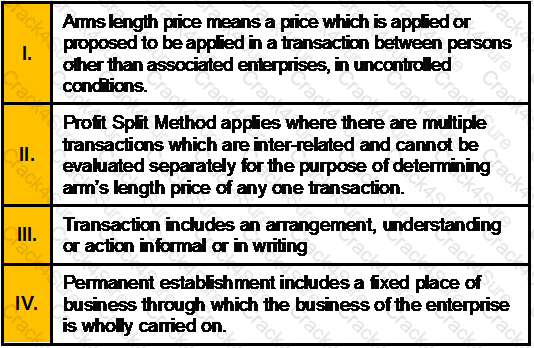
Section C (4 Mark)
Mr. Mahesh Chabaria, aged 52 years, currently owns an transport firm. His family consists of his wife Nitika, also aged 52 years, son Manish aged 29 and daughter Nidhi aged 27. Nitika is a housewife and both the children are happily married and well settled. The couple anticipates their life expectancy to be 80 years each.
Income and Expenses:
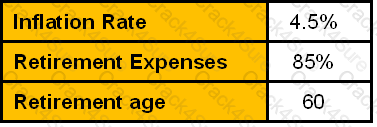
The gross annual income of Mahesh for the previous year 2007-08 is expected to be Rs. 1000000. The couples’ household expenses are estimated to be Rs. 32000 per month. Taking into account incidental expenses of another Rs. 5000 the net expenses of the family are estimated to be Rs. 37000 per month for the previous year 2007-08. Mahesh has a net saving of Rs. 1800000 which he would like to invest for his post retirement purposes.
Assets Allocation:
Mahesh has hardly 8 years left for retirement and thus he is not very aggressive in his investments. Returns of his portfolio based on asset allocation during the accumulation and distribution phase are calculated as below:
Assumptions:
Section A (1 Mark)
These people are so well balanced, they cannot be placed in any specific quadrant, so they fall near the center.
Section A (1 Mark)
What amount needs to be invested today at 10 % per annum, so that it pays Rs. 1 lac per annum for 5 years, starting from 6th year to 10thyear. First payment starts at BEGIN of 6thyear.?
Section A (1 Mark)
A(n)____________________________________________ is where the customer can use the difference between some percentage of the appraised value of their home and the mortgage remaining to secure a loan. This loan can be used to fund a college education, pay for a vacation or pay for home improvements.
Section C (4 Mark)
Which of the following statements are correct?
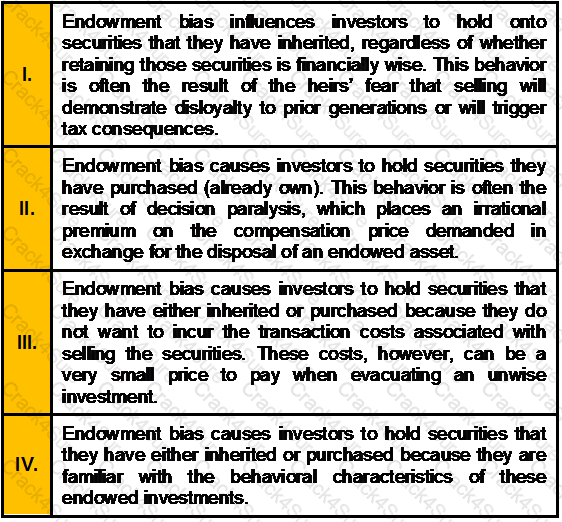
Section C (4 Mark)
Mudra Financial is a large financial firm which owns several mutual funds. The funds are managed individually by portfolio managers but it has an investment committee that overseas all of the funds. This committee is responsible for evaluating the performance of the funds relative to the appropriate benchmark and relative to stated investment objectives of each individual fund. During a recent investment committee meeting, the poor performance of Its Equity Funds were discussed. In particular, the inability of the portfolio managers to outperform their benchmarks was highlighted. The net conclusion of the committee was to review the performance of the manager responsible for each fund and dismiss those managers whose performance had lagged substantially behind the appropriate benchmark.
The fund with the worst relative performance is the Mudra Large Cap Fund which invests in large cap stocks. A review of the operations of the fund found the following:
• The turnover of the fund was almost double that of other similar style mutual funds
• The fund’s portfolio manager solicited input from her entire staff prior to making any decision to sell an existing holding
• The beta of the Mudra Large Cap Fund’s portfolio was 65% higher than the beta of other similar style mutual funds
• The portfolio manager refuses to increase the Capital Goods sector weighting because of past losses the fund incurred in the sector
• The portfolio manager sold all the fund’s Oil Marketing Companies stocks as the price per barrel of oil rose above $105. He expects oil prices to fall back to the $80 to $85 per barrel
• No stock is considered for purchase in the Large Cap Fund unless the portfolio manager has 10 years of financial information on that company.
The underweighting of the Capital Goods sector and selling off Oil Marketing Stocks could be best described as an example of:
Section B (2 Mark)
Pranoy is entitled to a basic salary of Rs. 5,000 p.m. and dearness allowance of Rs. 1,000 per month, 40% of which forms the part of the retirement benefits. He is also entitled to HRA of Rs. 2,000 p.m. He actually pays Rs. 2,000 p.m. as rent for a house in Delhi. Compute the taxable HRA.
Section B (2 Mark)
A bank recently loaned you Rs15,000 to buy a car. The loan is for five years (60 months) and is fully amortized. The nominal rate on the loan is 12 percent, and payments are made at the end of each month. What will be the remaining balance on the loan after you make the 30th payment?
Section A (1 Mark)
After originally investing Rs10,000 and selling your investment for Rs 12,000, you reinvest the total amount and tell yourself that you will not be concerned if you lose Rs 2,000 in this new investment. You are likely demonstrating which type of judgment error?
Section A (1 Mark)
The eligibility Criteria for Personal Loans Salaried Individuals for Maximum Age of Applicant at Loan Maturity in case of personal loan is:
Section A (1 Mark)
Investments that are difficult to convert to cash are said to have _________
Section C (4 Mark)
A trader buys three-month put options on 1 unit of gold with a strike of Rs.17000/10 gms at a premium of Rs.70. Unit of trading is 1kg. On the day of expiration, the spot price of gold is Rs.16800/10 gms. What is his net payoff?
Section B (2 Mark)
Eric, who has lived in the Netherlands for the whole of his life, arrives in the UK on 1 June 2011 and remains in the UK until 31 December 2011, when he returns permanently to the Netherlands. His UK residence status for 2011-12 is:
Section C (4 Mark)
Read the senario and answer to the question.
What amount he would have piled up at the end of the 20 years if it earns 8.5% compounded interest and discontinues making deposits after 9th deposit?
Section A (1 Mark)
When two banks simply agree to exchange a portion of their customers' loan repayments, they are using:
Section B (2 Mark)
A stock with a Beta of 0.7 currently priced at Rs 50 is expected to increase in price to Rs 55 by year end and pay Rs 1 as dividend. The expected market return is 15% and the risk free rate is 8%. The stock is:
Section A (1 Mark)
Customer service facilitation includes EXCEPT:
Section A (1 Mark)
A ____________________ tax system takes the same percentage of each person's income, regardless of whether the income is high, medium, or low.
Section A (1 Mark)
Customer services are defined as:
Section B (2 Mark)
Investors will choose investments that resonate with their own personality or that have characteristics that investors can relate to their own behavior. Taking the opposite view, investors ignore potentially good investments because they can’t relate to or do not come in contact with characteristics of those investments. For example, thrifty people may not relate to expensive stocks (high price/earnings multiples) and potentially miss out on the benefits of owning these stocks.
Which of the following Availability Bias have been exhibited in the case above?
Section A (1 Mark)
Debt investments in real estate, such as mortgages or deeds of trust, are called income property investments.
Section B (2 Mark)
Retiring early will ____________ the accumulation phase while ____________ the retirement phase
Section A (1 Mark)
A call option on a stock is said to be in the money if
Section A (1 Mark)
A type of investor who is willing to risk his own capital and give up security to gain wealth is known as:
Section A (1 Mark)
“Early accumulation” life stage is normally during ______
Section A (1 Mark)
Which of the following is a challenge of making a consumer loan?
Section B (2 Mark)
Accrued Interest on loan for self occupied property is Rs.110000 till 31 March 2010. Loan was taken for construction on 31/07/2006 and construction completed on 03/04/10. Interest for the year 2010-11 is Rs 22000. Determine what interest shall be allowed u/s 24(b) for AY 2011-12.
Section C (4 Mark)
Consider the multifactor APT. There are two independent economic factors, F1 and F2. The risk-free rate of return is 6%. The following information is available about two well-diversified portfolios:
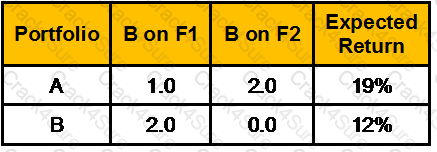
Assuming no arbitrage opportunities exist, the risk premium on the factor F1 portfolio should be __________.
Section C (4 Mark)
The expected return and standard deviations of stock A & B are:
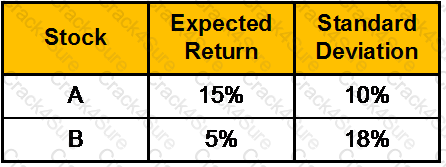
Amit buys Rs.20,000 of Stock A and sells short Rs.10,000 of Stock B using all the Proceeds to buy more or Stock A. The correlation Between the two securities is .35. What are the expected return & standard deviation of Amit’s portfolio?
Section B (2 Mark)
If a portfolio manager has a good ability to select undervalued securities but a poor ability to forecast overall market, the following makes sense for him:
Section A (1 Mark)
In US, how many states do not have a corporate income tax?
Section B (2 Mark)
Calculate the Information Ratio from the following data:

Section A (1 Mark)
The minimum income criteria for Personal Loans in case of Salaried employees is:
Section A (1 Mark)
______________are bonds issued by governments that pledge their "full faith and credit," including tax revenues, to repayment in US.
Section C (4 Mark)
You have collected the following information regarding Companies C and D:
The two companies have the same total assets.
The two companies have the same operating income (EBIT).
The two companies have the same tax rate.
Company C has a higher debt ratio and a higher interest expense than Company D.
Company C has a lower profit margin than Company D.
Based on this information, which of the following statements is most correct?
Section A (1 Mark)
The information in your credit report is primarily used by the credit bureau to compute your
Section C (4 Mark)
Maxis Ltd reported Earnings Per Share of Rs 2.10 in 1993, on which it paid dividends per share of Rs 0.69. Earnings are expected to grow 15% a year from 1994 to 1998, during which period the dividend payout ratio is expected to remain unchanged. After 1998, the earnings growth rate is expected to drop to a stable 6%, and the payout ratio is expected to increase to 65% of earnings. The firm has a beta of 1.40 currently, and it is expected to have a beta of 1.10 after 1998. The Risk Free Rate of Return is 6.25%.
What is the value of the stock, using the two-stage dividend discount model?
Section A (1 Mark)
Holistic advisory services which cater to specific client segments such as entrepreneurs, professionals are known as_______________.
Section A (1 Mark)
The____________________ in commercial real estate requires that the tenant pay a significant share of expenses of operation, as well as all taxes and insurance related to their rental unit.
Section C (4 Mark)
Arvind Ltd. currently EPS is Rs.5. Its return on equity (ROE) is 25% and it retains 60% of its earning. Stocks of similar risk are priced to return 18%. What is the intrinsic value of Arvind Ltd’s Stock?
Section C (4 Mark)
Read the senario and answer to the question.
Ms. Deepika is interested in investments in foreign markets. Her brother is working in one of reputed American company in India and that is offering him some shares under ESOP scheme. This company is not listed in India. It is listed in New York Stock Exchange. Ms. Deepika is asking her manager how this transaction will took place for her brother?
Section A (1 Mark)
Which of the following statements regarding debit and credit card liability is correct?
Section A (1 Mark)
_____________ is defined as fairness in spending in US.
Section A (1 Mark)
A(n) _____________ is an assurance that investors will be repaid in the event of the default of the underlying loans in a securitization. These can be internal or external to the securitization process and lower the risk of the securities.
Section B (2 Mark)
If a portfolio manager has a good ability to forecast overall market but a poor ability to select undervalued securities, the following strategy would suit best to him.
Section C (4 Mark)
Read the senario and answer to the question.
Jogen commuted his 40% of pension in April, 2008 with Rs. 2,15,000.What would be the taxable amount on commuted pension received by Jogen, if he would retire from a private organization?
Section B (2 Mark)
A fixed-rate mortgage for Rs210 000 with monthly payments is amortized over 20 years. The interest rate is 4.85% compounded semi-annually for a 7-year term. How much of the mortgage principal has been repaid by the end of the 7-year term?
Section B (2 Mark)
Mr. Subhash Bansal, a marketing manager is employed with IMFB limited. He took an advance of Rs. 1,20,000 against the salary of Rs. 30,000 per month in the month of March 2007. The gross salary of Mr Bansal for the assessment year 2007-08 shall be:
Section A (1 Mark)
A put option on a stock is said to be out of the money if
3 Months Free Update
3 Months Free Update
3 Months Free Update